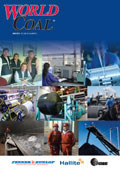Editorial comment
The Q1 reports of the mining majors this month have, at times, read more like weather reports than company results. The impact of the Queensland floods dominates: BHP Billiton, Rio Tinto and Anglo American all report production volumes down for Australian metallurgical coal, although thermal coal production was balanced with increased production from New South Wales. According to estimates from Peabody Energy, Australian shipments were reduced by more than 25 million t.
Register for free »
Get started now for absolutely FREE, no credit card required.
Wet weather was not confined to Australia, though, as across the southern hemisphere supply was constrained by heavy rain. Set against double-digit growth rates for coal-fired electricity in India and China and an estimated 10% increase in global steel production, it is not a surprise to see record price settlements being recorded for both metallurgical and thermal coal.
Gregory Boyce, chairman and CEO of Peabody Energy and a recent commentator in this magazine, sees this as further evidence of “coal’s global supercycle”. It is hard to disagree with him. The fundamentals are strong and will remain so. Asia's continued development – its industrialisation, urbanisation – will be based on coal-fired power, just as Europe and North America’s was in the 19th century.
The mining majors recognise this and are investing in new resources. At the time of writing, Rio Tinto had achieved control for 72% of Riversdale Mining and its significant tier 1 projects in Mozambique. BHP has a number of projects in the pipeline in Australia having commenced the expansion of the Daunia metallurgical coal mine, the stage three expansion of the Hay Point coal terminal and the Broadmeadow life extension project. It has also approved the RX1 project at Hunter Valley Energy Coal. Peabody is bidding to develop a vast metallurgical coal project in Mongolia and has agreements in place to expand its access to Indonesian markets and develop large surface operations in the Xinjiang and Inner Mongolia autonomous regions of China.
The simple geographical range of the projects gives some idea of the challenge that meeting growing demand will pose over the coming years. Coal will be pulled into Asia from an increasingly wide circle. Peabody is to develop a West Coast export terminal to send up to 24 million tpa of Powder River Basin coal to Asia; Arch Coal expects US coal exports to all destinations to reach 104 million t this year. The landscape of the coal industry is changing: we’re in for quite a ride.


